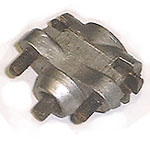Brakes
The origin of the brakes is Triumph Herald/Spitfire. The first S2 has drum brakes at the front, but mine has luckily been converted to disc's. The brakes needed an overhaul with new pistons and seals. The calibers has been shot blasted and electroplated in a silver finish. Looks nice, but I wonder for how long?
Front brakes:

Rear brake (Triumph):
.jpg)

Brake adjuster (rear) Girling part 64217022 (O.E. Part No. 37H6134).

is also fitted to:
Austin: Cambridge, Allegro, Maxi, 1800 & 2200
Morris: Marina, Oxford
Ford: Cortina Mk1, Escort Mk1
Triumph: Herald, Spitfire, Vitesse
MG: Magnette
Rear Wheel Cylinders
 There are at least 3 different bore sizes availible (0.625", 0.700" and 0.750").
There are at least 3 different bore sizes availible (0.625", 0.700" and 0.750").It probably matters more that you have a matched pair of rear cylinders
than exactly which size they are. Otherwise, unbalanced braking will result.
Having said that the smaller bore size will give less change of the rear brakes "locking up" under heavy braking. However, a better approach is to increase the braking effort of the front disc brakes. More efficient braking up front will result in lower hydraulic line pressures with less chance of rear brake lock up.
Make your own ĎOne-Man-Brake-Bleedí kit
Take a length of fuel line or some similar tubing which will fit over the bleed nipples of your Brake Calipers/Slave Cylinders. Find a bolt which fits securely into one end of the tube and screw it into the tube. (The idea is to block off one end of the tube.) Take a sharp knife and cut a 20mm slit in the tube, as close to the bolt as you can. (The idea here is to provide a means for the air to escape from the blocked tube.) Put the open end of the tube over the bleed nipple and the blocked end into a jar of some sort. (Make sure the jar isnít going to fall over!) Crack open the bleed nipple about 1/4 of a turn. Make sure the Fluid resevoir on whichever system you are bleeding is topped up.Press the pedal slowly.
The air should be pushed out of the slit in the tube due to the pressure from the pedal, but should not be able to get back into the tube due to the rubber sealing up the hole. Once there is fluid inside the pipe, the seal will be even more effective.
Remember to check the fluid level after every few pumps of the pedal.